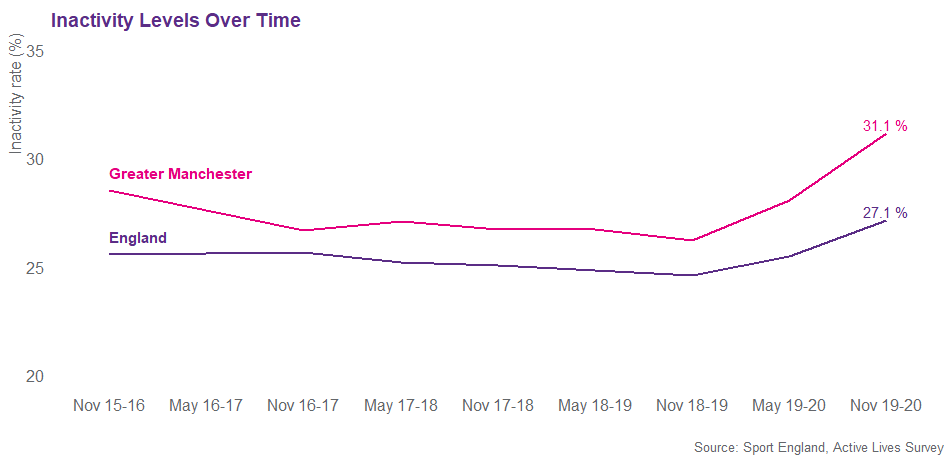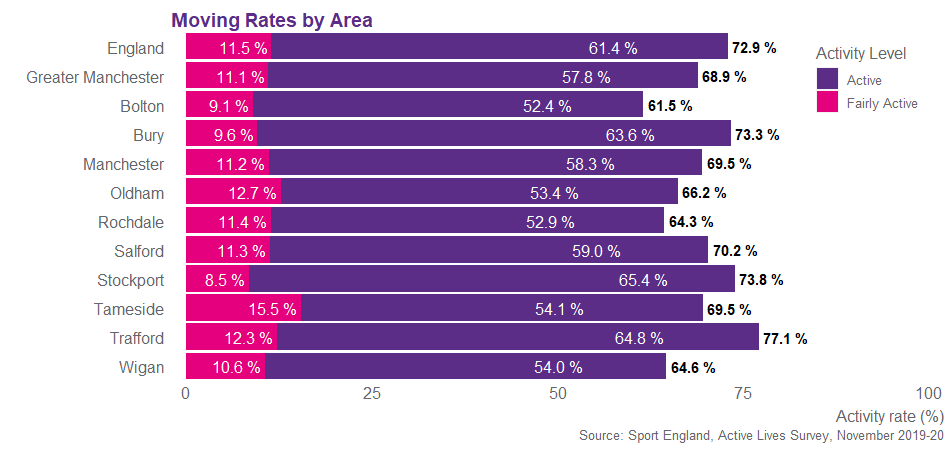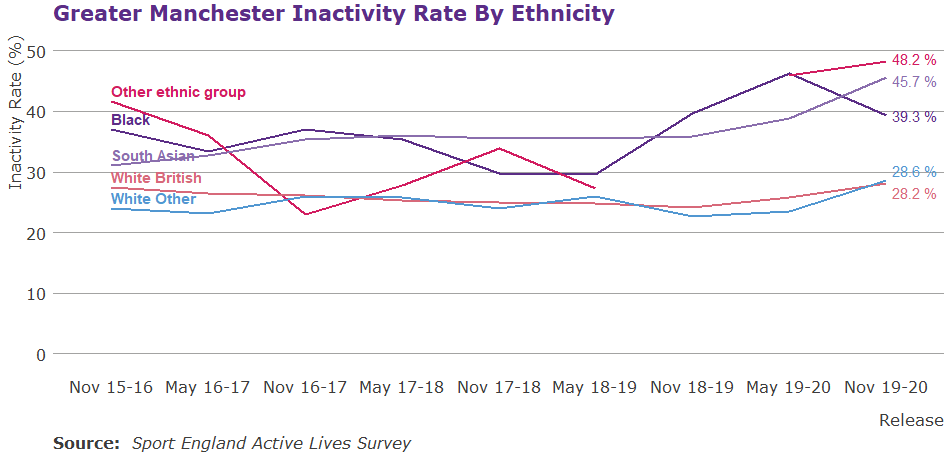Greater Manchester Adult Activity Levels November 2019-20
The latest Active Lives results published by Sport England show that 68.9% of adults in the region are active for at least 30 minutes a week, equating to 1,551,900 adults moving; a decrease of 98,000 from the survey 12 months ago.
Greater Manchester Overview

Moving Rates
The latest Active Lives data shows that there has been a decline in activity levels across Greater Manchester. 68.9% of adults in Greater Manchester are now moving (active and fairly active), this equates to 1,551,900 adults, in comparison 72.9% of adults are moving nationally. In the past 12 months the moving rate has declined by 4.9% in Greater Manchester.
Inactivity
Since Active Lives launched, November 2015-16, the inactivity rate has increased by 2.6%, meanwhile nationally there has been a 1.6% increase. This widening of the inactivity gap, between Greater Manchester and England, has primarily been driven by changes in activity over the last 12 months, in Greater Manchester inactivity rates have increased at almost twice the national rate, 4.9% compared to 2.6%.

When this latest data is combined with activity data on children and young people the position towards our targets can be seen;

Find out more about activity levels of children and young people in Greater Manchester here.
Differences across the boroughs
There remain clear differences in activity levels across the boroughs of Greater Manchester with three boroughs above the national average for moving, Bury, Stockport and Trafford. However, the gap between the boroughs with the highest and lowest levels of moving now stands at 15.6%, compared to 11.4% in November 2015/16.

Demographic data
 |
The inactivity gender gap in GM is 2.3%Since November 15/16 the gender gap has decreased by 0.8%. This has been driven by a greater increase in inactivity amongst men (+2.9%) than amongst women (+2.0%). |
 |
The inactivity socio-economic gap in GM is 24.2%Since November 15/16 the socio-economic gap has increased by 5.5%. This is a result of a minor increase in inactivity amongst higher social groups (+1.0%) and a large increase amongst lower social groups (+6.5%). Learn more about activity levels related to socio-economic status here |
 |
The inactivity disability gap in GM is 19.4%Since November 15/16 the disability gap has decreased by 3.3%. This has been caused by an increase in inactivity amongst those with no long term limiting disabilities (+3.4%) and no change in inactivity rates amongst those with long term limiting disabilities (0.0%). Learn more about activity levels related to disability and long term health conditions here |
 |
The inactivity age gap in GM is 27.8%Since November 15/16 the age gap has decreased 7.4%. This has been driven by an increase in inactivity amongst 16 to 34 year olds (+5.4%) and a decrease in inactivity amongst over 75's (-2.0%). |
 |
Ethnicity and activity levelsDue to the nature of ethnicity data we do not calculate an inactivity ethnicity gap. South Asians have seen the greatest increase in inactivity since baseline (+14.5%), whilst this has been a steady increase, the last 12 months have seen a much faster increase in inactivity with rates rising 9.8% in this time. Other Ethnic Groups have had the second largest increase (+6.6%), however there has been greater fluctuation in their inactivity rates over time, in November 2016/17 they had lowest levels of inactivity. However, those identifying as Chinese or Mixed are the only two groups to see a decline in inactivity since baseline with 5.1% and 8.7% decreases respectively, unfortunately both these cohorts lack a full time-series dataset so the pattern over time is more challenging to understand. |
|
|
If you have questions about this data please email: [email protected]
All data is rounded to one decimal point, you can access the raw data here.
Published June 2021

